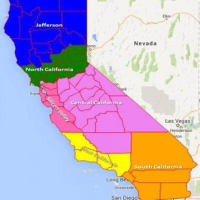“Six Californias” Fails to Get Enough Signatures to Be on the Ballot

The proposed ballot measure to divide California into six states turned out to be a lot more popular on Google, where a simple query shows 141,000 results, than among potential voters.
The California Secretary of State announced last Friday that Silicon Valley millionaire Tim Draper’s initiative fell short of the number of signatures necessary to qualify for the ballot in November 2016. Although he turned in 1.14 million signatures (pdf), far more than the required 807,615, a random sample of 54,000 of them indicated that a third were invalid.
No explanation was given about why the signatures were invalid, and Draper, who spent $5 million on the venture, said in a statement he wasn’t giving up. “We will work with the Secretary of State to verify all of the signatures gathered during the petition process.”
She might be a little preoccupied. Right now, the Secretary of State Debra Bowen is living in a trailer park, battling depression and working from home in preparation for the November 4 election.
Draper expressed confidence in assurances he received from his signature-collection contractor, Arno Political Consultants, that they had plenty of valid ones and said the secretary’s actions are “yet another example of the dysfunction of the current system and reinforces the need for six fresh, modern governments.”
Arno is one of the larger signature-gathering firms in the country. By its own count, the firm has collected more than 120 million signatures to qualify more than 500 ballot initiatives in 20 states since its founding in 1979. The consulting firm lists five major publications that have praised its work, but doesn’t link to any of the stories. Arno’s brief Wikipedia entry does not mention the kudos, but links to five stories describing allegations of petition fraud and controversy in campaigns.
Draper, a fourth-generation venture capitalist who made a lot of his own money backing tech startups, proposed carving California up into six states: Jefferson, North California, Central California, Silicon Valley, West California and South California. Some would be dirt poor, like Jefferson, and some would be fabulously wealthy, like Silicon Valley.
Jefferson includes Chico, Redding and Eureka up by the Oregon border. North California sits in a horizontal strip beneath it and includes Sacramento. Central California stretches from Stockton to below Bakersfield and Silicon Valley hugs the coast from the San Francisco Bay Area to below Big Sur. West California also hugs the coast from above San Luis Obispo to Los Angeles and includes Santa Barbara. South California has San Diego, Riverside and a lot of desert.
A study (pdf) by the independent state Legislative Analyst’s Office noted that Silicon Valley would have roughly twice the per capita personal income of the poorest new state, Central California.
The measure would have amended the State Constitution to allow the division. Legislation to create the new states would have to be approved by a majority of members in the U.S. House of Representatives and Senate. The President would have to sign off on it too or have his veto overridden.
Californians have been talking about splitting up the state since before there was a California. The terms of statehood agreed to in 1850 rejected calls to divide the state in two. But 10 years later, the state Legislature agreed to let Southern California voters decide if they wanted to spin off into a separate state.
They needed two-thirds approval and got three-fourths. But federal lawmakers never brought it up for a vote and it died. Since then, a number of Northern California counties have attempted to secede from the state and align themselves with each other or disenchanted Oregon counties. So far, the Golden State has not proven to be that malleable.
–Ken Broder
To Learn More:
Six Californias Initiative Fails to Qualify (by Jim Miller, Sacramento Bee)
"Six Californias" Initiative Fails to Qualify for Ballot (by Josh Richman, San Jose Mercury News)
Initiatives and Referenda Failed to Qualify (California Secretary of State’s Office)
Analysis of Six Californias (Legislative Analyst’s Office) (pdf)
- Top Stories
- Controversies
- Where is the Money Going?
- California and the Nation
- Appointments and Resignations
- Unusual News
- Latest News
- California Forbids U.S. Immigration Agents from Pretending to be Police
- California Lawmakers Urged to Strip “Self-Dealing” Tax Board of Its Duties
- Big Oil’s Grip on California
- Santa Cruz Police See Homeland Security Betrayal in Use of Gang Roundup as Cover for Immigration Raid
- Oil Companies Face Deadline to Stop Polluting California Groundwater





